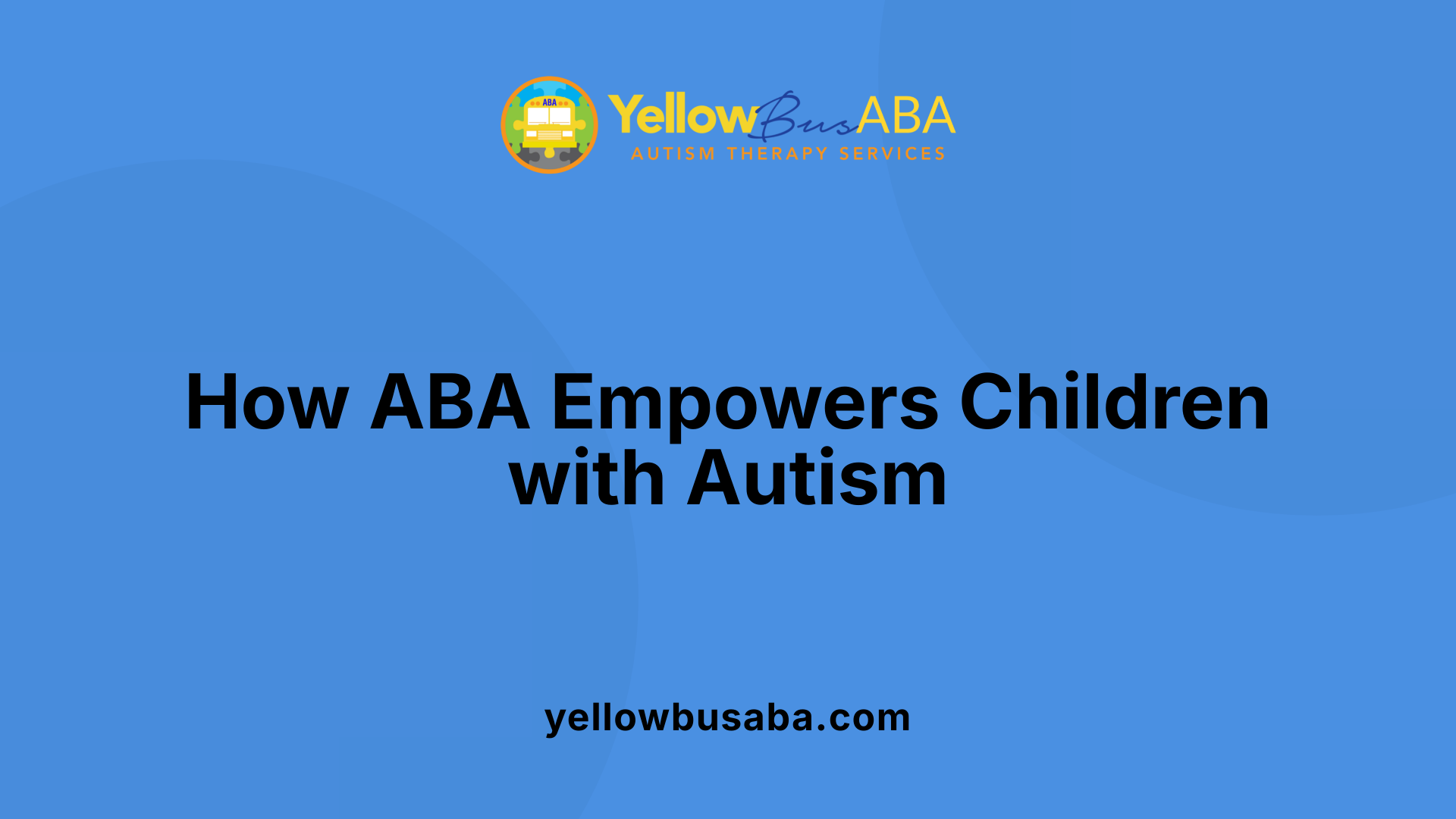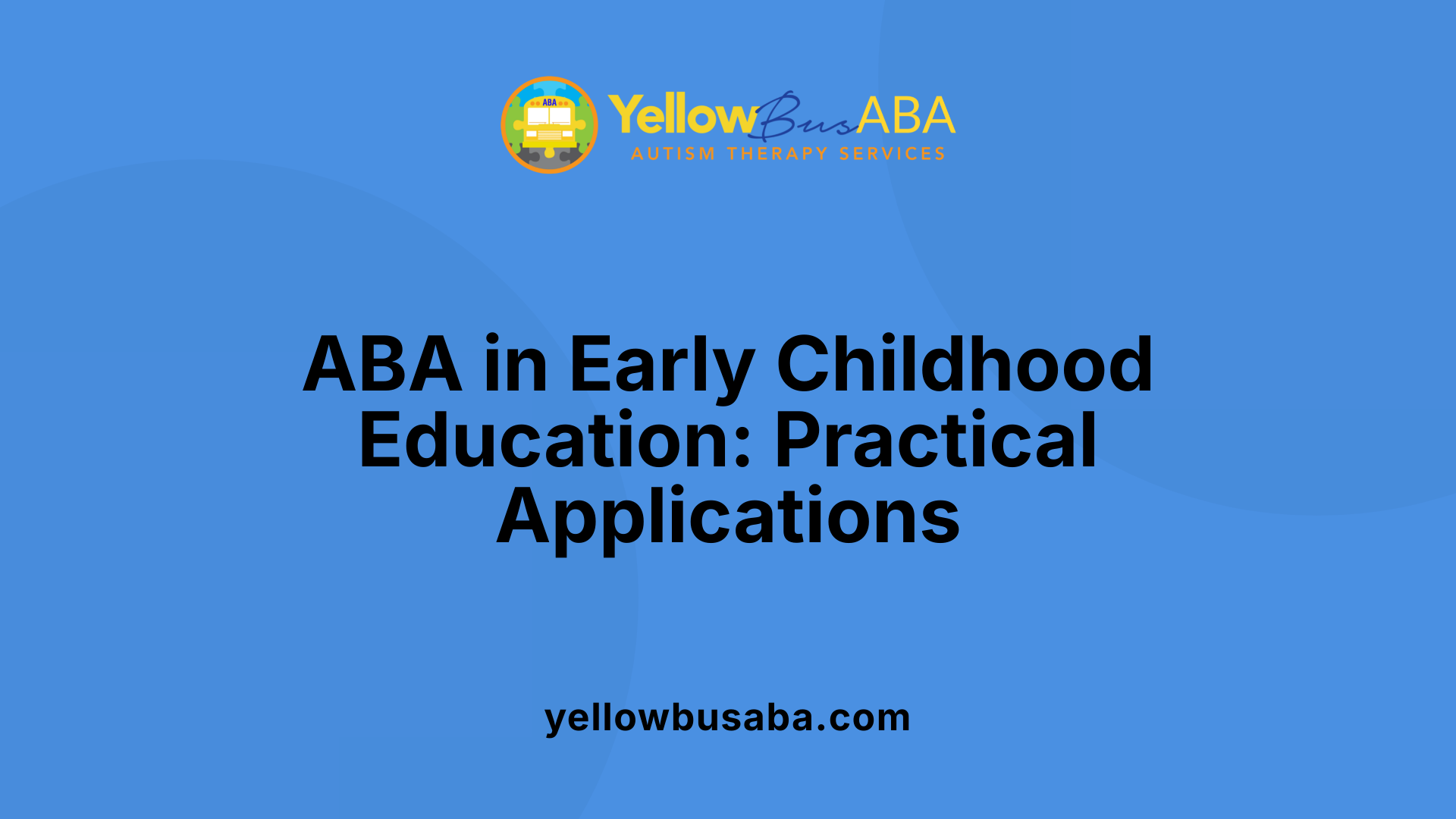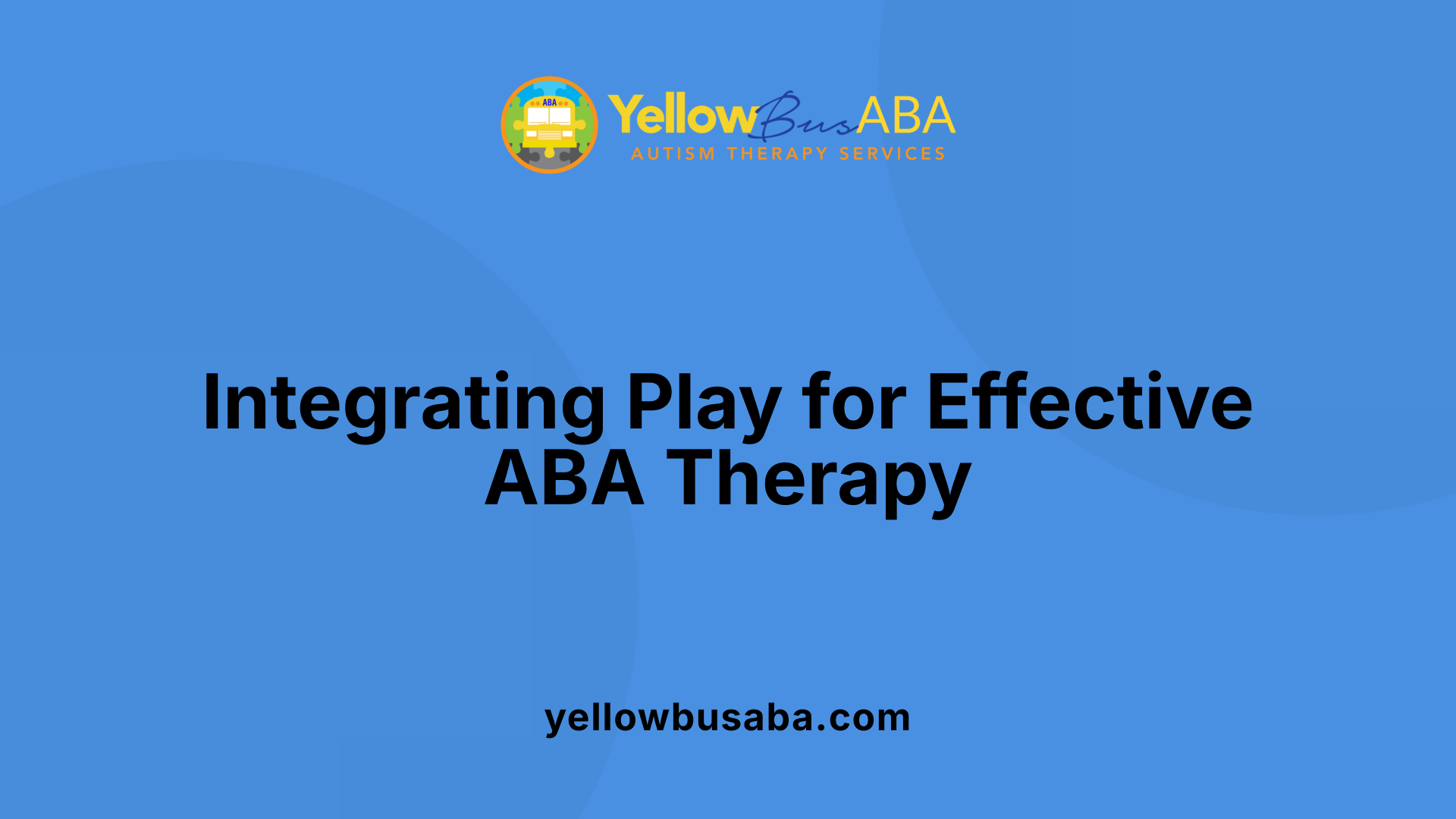Building Foundations for Lifelong Success
Applied Behavior Analysis (ABA) therapy has emerged as a vital, evidence-based approach in supporting early childhood development, especially for children with autism and other developmental challenges. By understanding how behavior works and applying scientifically grounded strategies, ABA helps children develop critical skills, reduce harmful behaviors, and foster independence. This article explores how ABA therapy is structured, its benefits, and its application in various settings to support the holistic growth of young children.
Understanding ABA Therapy and Its Role in Early Childhood.

What is ABA therapy and how does it support early childhood development?
Applied Behavior Analysis (ABA) therapy is a scientifically-supported approach that focuses on understanding and modifying behavior through learned responses and environmental factors. It uses the principles of learning—like reinforcement—to encourage positive behaviors and reduce challenges.
In early childhood, ABA helps children develop essential skills such as communication, social interaction, and self-care. For children with autism and other developmental delays, ABA provides customized strategies to promote independence and improve overall functioning.
Practitioners assess individual behaviors and their environments, then apply techniques like positive reinforcement—offering valued rewards—to motivate children. The therapy often includes play-based and experiential activities to make learning engaging and effective.
Professionals trained in ABA design and oversee personalized programs, aiming for meaningful progress in both short-term skills and long-term independence. Early intervention with ABA has been proven to yield significant developmental improvements, fostering a better quality of life for children as they grow.
Core Principles and Techniques of ABA.

What principles and techniques are used in ABA therapy?
Applied Behavior Analysis (ABA) therapy is built on solid scientific foundations rooted in understanding learning processes and behavior patterns. It employs a variety of strategies designed to promote positive, lasting change in children, especially those with autism.
One of the most fundamental principles is positive reinforcement. This technique involves rewarding desired behaviors to increase their likelihood of recurrence. For example, a child might receive praise or a token for demonstrating a new skill, encouraging them to repeat the behavior.
Another core component is prompting, which provides hints or cues to help children perform desired behaviors. Prompt fading gradually reduces assistance, enabling children to perform independently. Techniques such as shaping and chaining are also central: shaping involves reinforcing successive approximations toward a target skill, while chaining teaches sequences of behaviors linked together.
Behavior analysis strategies focus on analyzing every part of a behavior through the antecedent-behavior-consequence (A-B-C) framework. This helps identify triggers and consequences that maintain behaviors, guiding effective interventions.
Common ABA techniques include discrete trial training, where structured, short trials teach specific skills, and natural environment teaching, which incorporates learning into everyday settings. Visual modeling and prompt fading help children acquire new skills with confidence, while behavior chaining links simple steps to form complex activities.
Each ABA program is tailored to the individual, with a qualified behavior analyst—like a Board Certified Behavior Analyst (BCBA)—designing personalized plans. These plans are grounded in ongoing data collection and progress monitoring, ensuring interventions are effective and adjustments are made as needed.
In summary, ABA combines scientific principles with practical techniques to facilitate meaningful behavior change. It emphasizes positive reinforcement, systematic prompting, and careful analysis of behavior patterns to support developmental goals across communication, social skills, and daily living activities.
Supporting Children with Autism and Developmental Challenges.

How does ABA therapy support children with autism and developmental challenges?
Applied Behavior Analysis (ABA) plays a vital role in supporting children with autism and developmental challenges. It employs evidence-based strategies to teach essential skills across multiple areas, including communication, social interaction, and daily living activities. ABA utilizes structured, individualized interventions designed to meet each child's unique needs, promoting skill acquisition in a systematic way.
Positive reinforcement is a core technique within ABA, encouraging children to repeat desired behaviors by providing rewarding stimuli. Consistency in routines reinforced by data-driven decisions helps children develop stability and confidence in their behaviors. Early intervention is particularly influential because it takes advantage of brain plasticity at a young age, leading to significant improvements in behavior and development.
Play-based and sensory integration techniques are integrated into ABA programs to support motor skills, coordination, and problem-solving. These methods make learning engaging and more natural, helping children generalize skills across different settings. Regular assessment and active caregiver involvement are essential components, ensuring that interventions are adapted as the child's needs evolve.
Tailored treatment plans focus on fostering meaningful progress, improving social skills, reducing challenging behaviors, and promoting overall independence. These targeted approaches not only support the child's development but also enhance their quality of life and ability to participate in everyday activities.
Application of ABA in Early Childhood Settings.

Can ABA therapy be applied in early childhood education settings?
Yes, ABA therapy is highly adaptable and is frequently implemented in early childhood environments to bolster learning and behavior development in young children. In preschool settings, ABA principles help teachers and therapists create individualized plans aimed at fostering skill development across multiple areas—communication, social interaction, self-care, and academic skills.
Structured techniques like breaking skills into manageable steps and using positive reinforcement to motivate children are foundational in these settings. Visual tools, such as picture schedules, social stories, and token systems, are commonly employed to aid comprehension and encourage desired behaviors. These tools are especially effective for children with autism, providing clear cues and consistent routines.
Educational programs integrate a variety of ABA methods, including discrete trial training, natural environment teaching, and sensory activities, to meet each child's unique needs. These approaches not only facilitate skill acquisition but also promote generalization and lasting mastery of skills.
Overall, ABA principles serve to improve development outcomes, support inclusive practices, and create a positive, engaging learning environment for all children.
Use of visual tools and reinforcement systems
Visual aids and reinforcement strategies are central to applying ABA in early childhood education. Visual supports like schedules, social stories, and visual cues help children understand expectations, follow routines, and demonstrate their understanding. Reinforcement systems—such as tokens, praise, or access to preferred activities—encourage children to repeat positive behaviors.
Using these tools consistently enhances learning, increases motivation, and provides immediate feedback, which is vital for children with diverse learning needs.
Benefits of structured and naturalistic approaches
Combining structured and naturalistic ABA techniques offers flexible, effective interventions. Structured approaches like discrete trial training focus on specific skill acquisition in controlled settings, ensuring precision and consistency.
Meanwhile, naturalistic methods incorporate learning into everyday routines and play, promoting skill generalization and spontaneous use of new skills. This blended approach supports children’s development across various environments—classrooms, homes, and community spaces—leading to more robust and meaningful progress.
Play and Interactive Strategies within ABA.

How is play integrated into ABA therapy and its benefits?
Play is an essential element of Applied Behavior Analysis (ABA) therapy, serving as a natural and engaging method to teach various skills. Therapists incorporate different types of play—structured play, free play, and sensory play—tailored to individual developmental needs. These play-based strategies make learning enjoyable and relevant, helping children develop critical social, communication, and problem-solving abilities.
Through play, children can interact with peers, express themselves, and reduce anxiety, which fosters motivation and participation in learning activities. Play also plays a significant role in assessment, as it allows therapists to observe behaviors, track progress, and identify areas for targeted intervention.
Data collection during play sessions enables therapists to reinforce desired behaviors with positive rewards, promoting skill acquisition. Overall, integrating play into ABA not only enhances skill development but also builds a positive, engaging environment that supports emotional well-being.
Parents and caregivers are vital in extending the benefits of play-based ABA. They can incorporate playful interactions into daily routines, create environments that encourage spontaneous play, and facilitate social interactions with peers. This involvement helps generalize skills learned in therapy to everyday situations, maximizing developmental progress and fostering a supportive network for the child.
Monitoring Progress and Ensuring Effective Outcomes.
What principles and methods are used to monitor progress in ABA?
ABA programs rely heavily on systematic data collection to evaluate each child's development over time. Behavior analysts and therapists gather data through various techniques such as frequency counts of specific behaviors, duration measurements, and ABC (Antecedent, Behavior, Consequence) charts. These methods enable precise tracking of progress in areas like communication, social skills, or reduction of problematic behaviors.
Setting personalized goals is an essential part of this process. Upon initial assessment, individualized progress targets are established, aligning with the child’s unique strengths and needs. Regular review meetings analyze the collected data, evaluating whether current interventions are effective or need modifications.
This approach also emphasizes collaboration among caregivers, teachers, and therapists. By sharing data and insights across different environments, consistency is maintained, which is critical for skill generalization and long-term retention.
Data analysis not only confirms whether a child is meeting short-term milestones but also informs future instructional planning. When progress stalls or regression occurs, the team can swiftly adjust strategies, ensuring interventions remain responsive and effective.
Overall, data-driven decision-making underscores all aspects of ABA, fostering a tailored, flexible approach that adapts to each child’s growth trajectory and enhances the likelihood of meaningful developmental achievements.
The Scientific and Policy Support for ABA.
What is the scientific basis and policy support for ABA therapy?
Applied Behavior Analysis (ABA) is firmly rooted in scientific principles of learning and behavior. Over the decades, rigorous research has consistently demonstrated its effectiveness in supporting developmental skills and addressing challenging behaviors, especially in children with autism. Since its application in the 1960s, studies and systematic reviews—more than 20—have showcased significant improvements in areas such as communication, social skills, attention, and daily living behaviors.
The effectiveness of ABA has earned recognition from leading health and psychological authorities. The US Surgeon General and the American Psychological Association have both endorsed ABA as an evidence-based best practice, emphasizing its scientific validation and versatility in customizing interventions based on individual needs.
Federal policies further bolster ABA’s importance in early childhood education. The Individuals with Disabilities Education Act (IDEA), first enacted in 1997 and amended several times until 2006, explicitly promotes the integration of research-backed practices like functional behavior assessments and tailored intervention plans. These policies require schools and early childhood programs to adopt data-driven decision-making, ensuring that each child’s development is supported by proven strategies.
Insurance coverage has also expanded, with many private health plans and Medicaid programs mandated to cover ABA services when medically necessary. This legislative support aims to improve access and affordability, making high-quality ABA therapy available to more children and their families.
In summary, ABA’s foundation in science, along with substantial policy initiatives, firmly establishes it as a cornerstone of early childhood intervention, especially for children with developmental delays and autism.
Conclusion: Empowering Children through ABA.
What is the importance of ABA therapy in early childhood and its long-term benefits?
Applied Behavior Analysis (ABA) plays a vital role in early childhood development, especially for children with autism and other developmental challenges. It provides these children with essential tools to improve communication, social skills, self-help abilities, and academically relevant behaviors. By reducing challenging behaviors such as aggression or self-injury, ABA helps create a safer and more engaging learning environment.
Early intervention with ABA is particularly powerful. The brain's plasticity during early years allows for more effective learning and skill acquisition. Implementing ABA strategies early helps establish strong developmental foundations that support future success in social interactions, education, and independence.
The personalized nature of ABA ensures that interventions are tailored to each child's strengths and needs. This targeted approach not only fosters confidence but also promotes a better quality of life. As research continues to demonstrate its effectiveness, ABA remains essential in shaping positive outcomes, providing children with the skills they need for lifelong growth and social participation.
The long-term benefits of early ABA intervention include improved communication, better social integration, higher academic achievement, and increased independence. These outcomes collectively contribute to a more successful transition into adulthood, enabling children to thrive in various life settings.
In sum, ABA offers a structured, evidence-based framework that empowers children to reach their full potential. Its ongoing integration into early childhood education promises continued advancements in supporting developmental progress and fostering resilient, capable individuals.
Fostering Growth and Independence Through Evidence-Based Practice
ABA therapy is a proven, adaptable, and highly effective approach to supporting early childhood development. It empowers children, especially those with autism, to reach their full potential by teaching vital skills, managing challenging behaviors, and promoting independence. Strengthened by robust research and policy support, ABA continues to evolve, integrating play, naturalistic strategies, and collaborative efforts to ensure every child's development is nurtured within a supportive environment. Early intervention with ABA not only transforms individual lives but also lays a solid foundation for lifelong success in learning, social interaction, and personal well-being.
References
- Applied Behavior Analysis in Early Childhood Education
- Applied Behavior Analysis (ABA) | Autism Speaks
- Preschool for Autism With The Help of ABA Therapy: A Complete ...
- How Early Intervention ABA Therapy Uses Play To Teach
- The Role of Applied Behavior Analysis (ABA) in Early Childhood ...
- Importance of ABA Therapy in Early Childhood Development
- Applied Behavior Analysis (ABA) | Autism Speaks



.jpg)

.avif)
